The full Strawberry Moon on June 3rd invites us to experience the refractive power of Earth’s atmosphere.
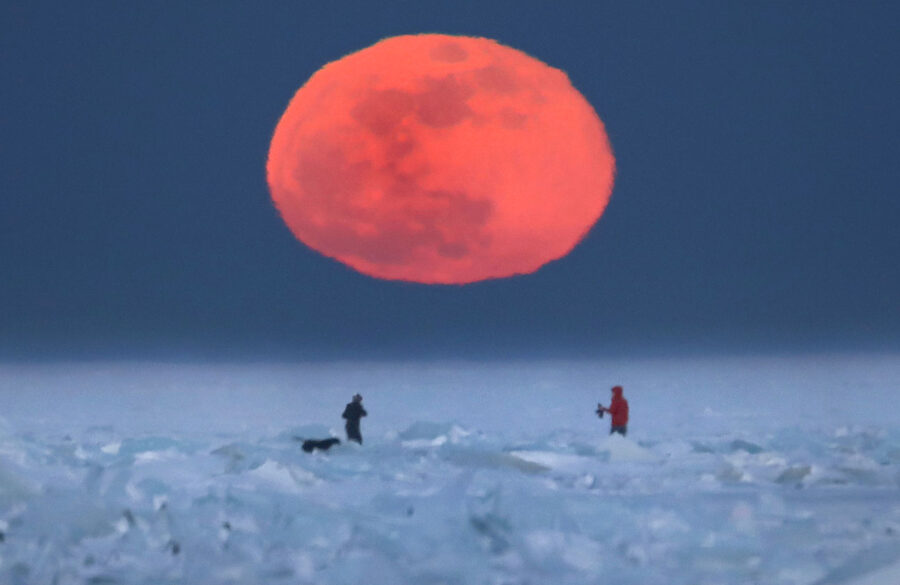
Bob King
On June 3rd the Strawberry Moon will rise just a few degrees east of strawberry-hued Antares in the constellation Scorpius around sunset. I may be a hardened deep-sky and comet watcher, but every month I look forward to watching the full Moon rise and flood the sky with light. Fortunately, I live near a lake with a great view to the east and a guaranteed front-row seat to this recurring and always moving sight. During a good part of the year, the Moon rises directly from the water, unobstructed by foreground trees or hills — ideal circumstances to see the prismatic prowess of Earth's atmosphere.
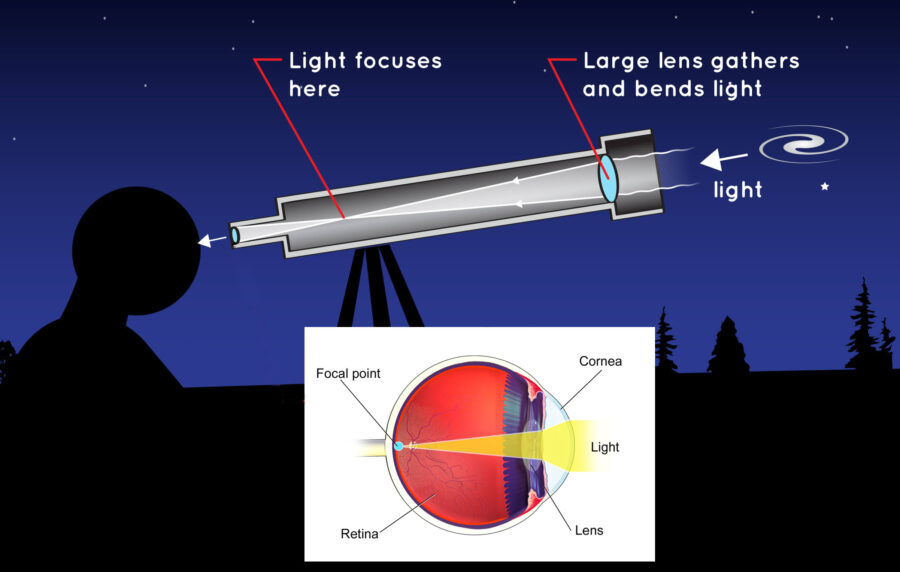
NASA / JPL-Caltech, Inset: Bruce Blaus, CC BY-SA 4.0
Refraction — or light's ability to bend — is ever-present. It paints rainbows, makes stars twinkle, and delivers the precious light of distant galaxies to our eyes when we peer through a refractor. Human vision would be impossible without it.
The principle is simple. When a light beam passes from one medium to another its speed and direction change. Light slows down when entering a denser medium and speeds up when entering a less dense medium. The change in speed alters the beam's direction. When light from a star strikes the Earth's atmosphere at any angle other than 90° (straight overhead), its trajectory bends upward from the horizon in the direction of the zenith.

Jeff Conrad / CC BY 3.0
Light from a star situated directly overhead experiences no refraction. If you see a star at the zenith that's where it is. But gradually lower your gaze toward the horizon, and refraction increasingly comes into play.
It begins subtly. The position of a star at an altitude of 45° shifts a mere 1′ (one arcminute) in the zenith's direction or upward. Even at 10° altitude the difference is only 5.4′ or about one-fifth the apparent diameter of the full Moon. But refraction quickly increases to 9.7′ at 5° , 21.8′ at 1°, 25′ at 0.5°, and 33.7′ (bigger than the full Moon) at the horizon. That's where the fun begins.
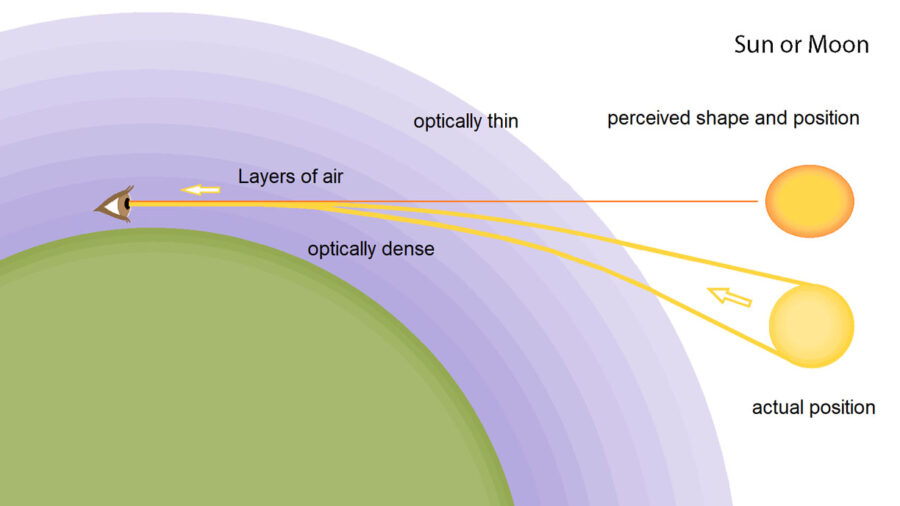
Sciencia58 / CC BY-SA 4.0
Refraction increases with the density of the medium. The amount of air directly overhead is 1 airmass by definition. At 30° above the horizon, it increases to 2 airmasses with minimal effect. But along the horizon we're looking through 40 airmasses, enough air to refract or "lift" the entire lunar disk into view even before it's risen. At that instant, if you could snap your fingers and make the atmosphere disappear, so would the Moon! On an airless Earth, we would have to wait an additional two minutes for every moon- and sunrise. Refraction likewise delays their setting time by the same amount. That's why daylight is actually a few minutes longer than nighttime on the so-called equinoxes.
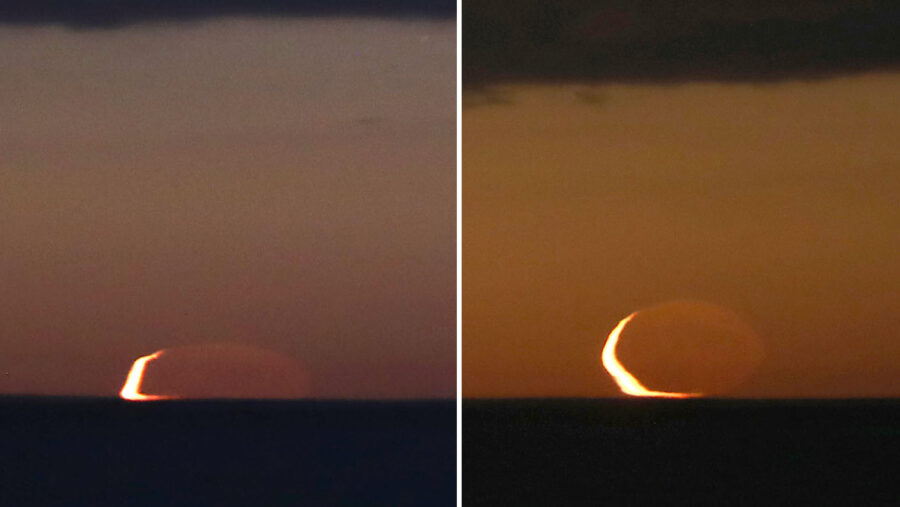
Bob King
Differential refraction neatly explains why the Moon looks like a beanbag chair at rising and setting. Atmospheric refraction at the horizon is ~34′ but diminishes to ~25′ just 0.5° above it. The bottom portion of the Moon, being closer to the horizon, gets "pushed" into the less refracted top. The difference of ~9′ from bottom to top is equal to almost a third of its diameter.
Flattening is even more dramatic from orbit. Astronauts on board the International Space Station see the setting Moon and Sun across a longer line of sight than the view from the ground. Correspondingly greater amounts of refraction flatten each body further into red M&M candies.
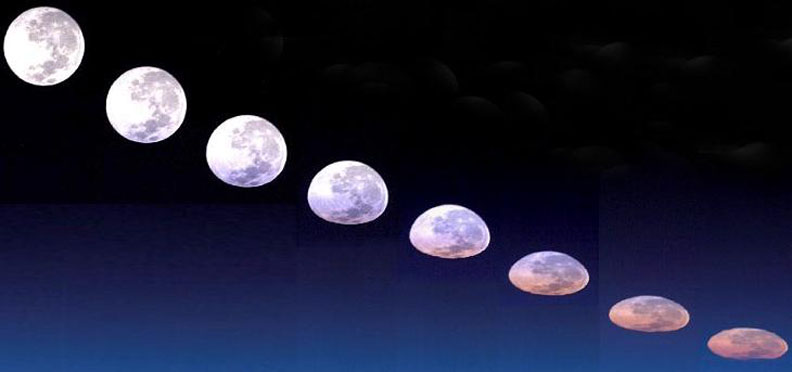
NASA
Atmospheric refraction is not a constant but varies according to temperature, humidity, and barometric pressure. That's why you won't ever see sunrise and sunset times listed to the second. Under the right circumstances, extreme temperatures and pressures refraction can increase refraction by 2° or more. In his book South!: The Story of Shackleton's Last Expedition 1914–917, polar explorer Sir Ernest Shackleton describes the reappearance of the Sun after the date of its predicted last appearance:
"The sun, which had made 'positively his last appearance' seven days earlier, surprised us by lifting more than half its disk above the horizon on May 8 [1915]. A glow on the northern horizon resolved itself into the sun at 11 a.m. that day. A quarter of an hour later the unseasonable visitor disappeared again, only to rise again at 11.40 a.m., set at 1 p.m., rise at 1.10 p.m., and set lingeringly at 1.20 p.m. These curious phenomena were due to refraction, which amounted to 2° 37′ at 1.20 p.m. The temperature was 15° below zero Fahr., and we calculated that the refraction was 2° above normal. In other words, the sun was visible 120 miles further south than the refraction tables gave it any right to be."
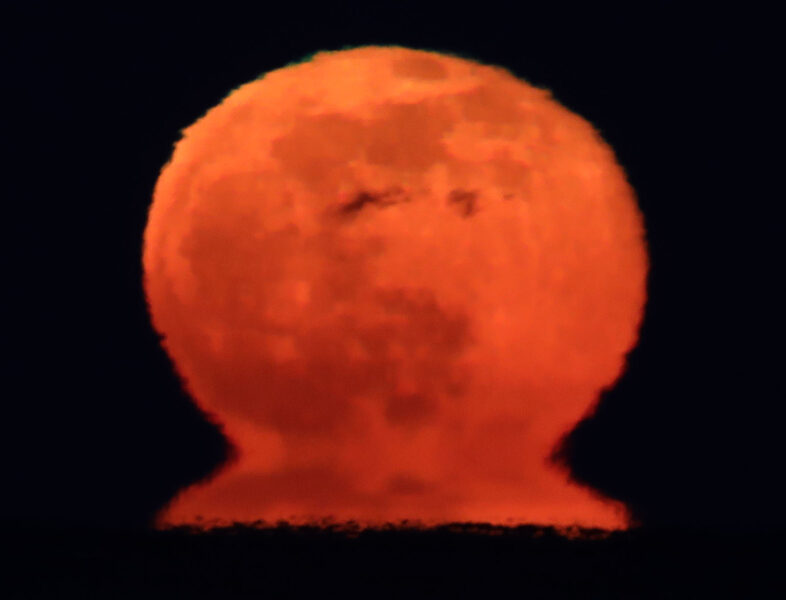
Bob King
I have not specifically looked for changes in the degree of refraction at the horizon from one full Moon-rise to the next, but I'm curious if routine observation and careful timing of successive moonrises (or sunrises) might expose this variability. Even a half-degree's difference should be easily noticeable with the naked eye. Has anyone else ever seen this?
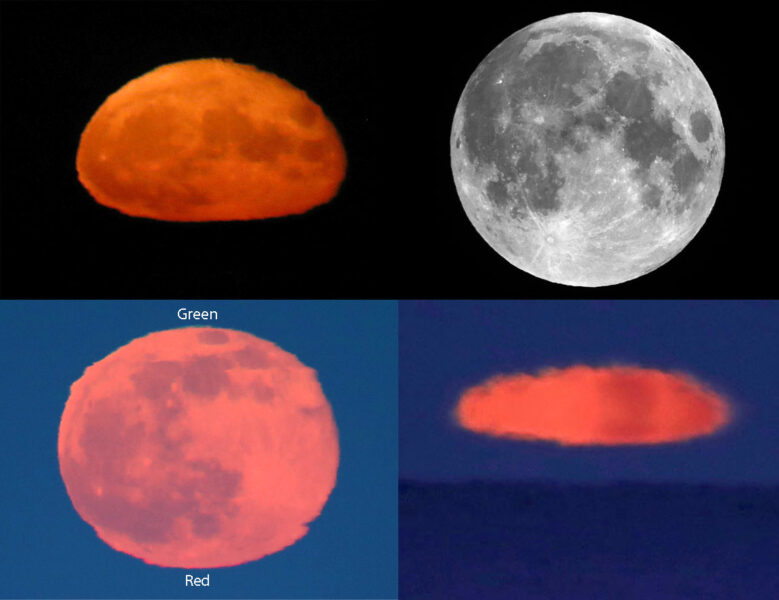
Bob King
Besides the gross effects of refraction at moonrise and sunrise, layers of air of different temperature and density along an observer's line of sight also get into the refractive act. Each layer bends light to a varying degree which can fray the Moon's edges, create moving ripples across its face, and greatly distort its shape. Mirages may also be present.
At full Moon, which occurs on Saturday, June 3rd at 11:42 p.m. EDT (3:42 UT on June 4th), we also have the chance to witness Earth's shadow and the Belt of Venus aligned with the rising Moon.
Be aware, though, that from many U.S. locations, the Strawberry Moon will rise very close to sunset, lessening its contrast with the surrounding sky. I hope you'll also make a date with the Moon in the nights that follow, when the waning gibbous will rise in a much darker sky. Find a spot with an unobstructed southeastern horizon and wait for the Moon to get bent out of shape.
 7
7









Comments
Anthony Barreiro
June 1, 2023 at 5:52 pm
Thank you Bob. This is fascinating!
In celestial navigation you start by measuring the angle above the horizon of a celestial object (the Sun or Moon during the day; a planet, star, or the Moon during twilight) and note the time, then you use information from the Nautical Almanac to calculate the point on the surface of the Earth where the object was directly overhead at the time of your observation. Further spherical trigonometry allows you to calculate your position relative to that point. Everything depends of the accuracy of the observed height of the object above the horizon, and that angle is always affected by atmospheric refraction. So you have to adjust every observation for atmospheric refraction, usually with a standard table, sometimes with additional corrections for temperature and atmospheric pressure under more extreme conditions. A rule of thumb is to always use objects that are well above 10 degrees above the horizon; below that refraction is too extreme and variable to provide an accurate position.
You must be logged in to post a comment.
Bob KingPost Author
June 2, 2023 at 12:15 am
Hi Anthony,
Thank you for your always thoughtful comments that expand in delightful ways on the topic at hand. Looking at that refraction curve, well above 10 degrees is a good rule of thumb.
You must be logged in to post a comment.
Repak
June 2, 2023 at 6:33 pm
I was a U.S. Air Force navigator on large aircraft for many years, well before anyone knew how to spell "GPS". Loved the job and very much enjoyed mastering celestial navigation, especially during long haul over water legs and also over the pole. Refraction was accounted for and object elevation was corrected for with look-up tables based on our aircraft altitude and observed elevation of the celestial object. Generally though, when possible, I avoided questionable accuracy refraction corrections of very low elevation objects.
You must be logged in to post a comment.
Bob-dBouncier
June 1, 2023 at 9:39 pm
Lovely video of "Earth Rise" from Japan's Kaguya. However, as I explained to my grandchildren, there is no actual "Earth Rise" on the moon. Like the Apollo picture with the same poetic name, it is just the appearance of earth near the horizon, which we liken to sun and moon rise. The Kaguya sequence is taken from the orbiting spacecraft, hence the 'rising'.
In reality, because the moon is tidally locked to the earth, we always see its same side. So, from any given point on the moon, earth will be always in the same position in the sky (with a few minor wobbles), never rising or setting, just waxing and waning.
You must be logged in to post a comment.
Bob KingPost Author
June 2, 2023 at 12:12 am
Hi Bob,
Of course you're right (and I knew that, re: the ISS photo sequence), but I let it go in the broader sense of "rising." But so there is no confusion I will make a note. I appreciate your comment, thank you!
You must be logged in to post a comment.
Frank-ReedNavigation.com
June 6, 2023 at 10:17 am
Fly to the Moon this week. Land in Mare Smythii on the Moon's equator at lunar longitude 90°E. Tomorrow, June 7, you will see the Earth rise! It will climb to a maximum altitude of a little more than 4.5° a week later, and then it will set again on June 21. The cycle will repeat every month (lunar month). So, yes, the Earth does rise and set as seen from the Moon, but it's a slow, stately motion, and --critically-- this is only visible for observers in the libration zones along the limb of the Moon. Specifically for the rising and setting dates I've described here, you would need to be standing in the middle of Mare Smythii. It's interesting to simulate this in planetarium apps, like Stellarium. Of course everywhere else on the Moon, outside of that belt around the Moon's visible limb, the Earth is either always in the sky, never setting, or, for observers on the Far Side, never in the sky, never rising.
You must be logged in to post a comment.
Frank-ReedNavigation.com
June 6, 2023 at 10:39 am
In general, refraction is not "simple", but in that portion of the sky where refraction is relatively simple, particularly above 45° in altitude, there is a remarkably easy rule for refraction: atmospheric refraction shrinks all angular distances and angular sizes by very nearly one part in 3000. It doesn't matter how the stars or other celestial bodies are oriented or positioned. All angles are reduced in direct proportion by 1/3000 (-ish!). The Big Dipper is just smaller when we see it high overhead, barely distorted in shape but measurably reduced in size ("measurably" with simple instruments like sextants). And the Moon and Sun, too, follow this simple rule, though it's much harder to measure. Anytime the Moon or Sun are high in the sky, to good approximation, the angular diameter is reduced by 1/3000, which is about half a second of arc. And surprisingly --surprising when you first think about it-- it's not just the vertical diameter that is compressed, as when the Sun and Moon are low in the sky, but the whole thing -- along any diameter the Sun or Moon are reduced in size by that same compression factor. Refraction shrinks the sky. 🙂
You must be logged in to post a comment.
You must be logged in to post a comment.